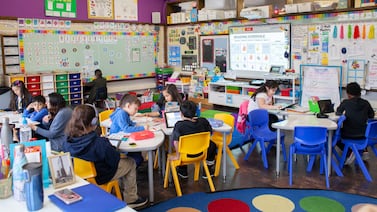Michelle Snyder’s job is to help more than 600 high school juniors and seniors through the college application process each year. It’s a daunting task in normal times, now made even tougher by the pandemic.
“The biggest tool in my toolbox was being able to walk to my classroom, grab the kid out of class and be like ‘Hey, this is due tomorrow,’” says Snyder, the college counselor for Crockett High School in Austin, Texas. “Right now, I’m just the scary college lady who sends emails.”
COVID is highlighting the downsides of losing face-to-face contact in many aspects of life, including education, just as more and more research underscores how critical school relationships can be to students’ success.
The latest example is a new study of College Forward, a Texas-based program designed to help low-income, first-generation students navigate the college application process. Students who randomly gained access to the program, which embeds recent college graduates in high schools like Crockett to offer support, saw their chances of enrolling in college jump by 8 percentage points.
The research contrasts with the disappointing recent results of low-cost efforts to boost college-going, while also pointing to a concrete way to help students from low-income families in the years ahead.
As more students return to school buildings, “Making sure that we continue to invest in these sort programs is going to be even more important,” said Gabrielle Lohner, one of the study’s authors.
College Forward embeds coaches in a number of Texas high schools, where they work with a group of first-generation or low-income students starting junior year.
At Snyder’s school, pre-COVID, the program offered after-school workshops on topics like filling out financial aid forms and one-on-one help from coaches. That support continues as students enter college.
“I’m in this environment of positivity and encouragement at all times,” said Alex Meija, describing his experience in College Forward at Crockett. Now a freshman in college, he joined College Forward with his best friend and quickly built a rapport with his coach, which helped ensure the college application process wasn’t just a difficult chore. “That’s honestly something every student needs.”
Not only are students in the program more likely to enroll in college — 66% versus 58% in a control group — they also are more likely to go to colleges with higher graduation rates, according to the study. Students who participated were also much more likely to have stayed consistently enrolled in college three years after high school: 45% versus 33%.
It’s too soon to say for sure whether the program affects students’ chances of actually earning a degree, but researchers will continue tracking it.
The evidence on College Forward is encouraging, even if the ongoing need for outside organizations to provide college help is disheartening to some.
“I don’t think College Forward should exist,” said Austin Buchan, the organization’s executive director. “In my perfect world, you better believe that we would not have a ridiculous student to counselor ratio in the state of Texas.”
But the kind of support College Forward provides is costly. The program spends $4,000 per student served, which perhaps explains why it doesn’t exist everywhere — and why enthusiasm has focused on low-cost alternatives in recent years.
A variety of those “low-touch” options have emerged as policymakers, researchers, and philanthropists, backed up by some initially encouraging research, hoped that low-income students might be “nudged” into college success. As those programs have expanded, though, research has shown they provide few, if any benefits.
An initiative by the College Board to mail packets of information about the college application process had basically zero effect on students’ likelihood of enrolling in college. A similar packet-mailing approach in Michigan also had little effect. Neither did a text message campaign encouraging students to fill out financial aid forms.
Another approach that has gained traction: virtual college advising, in which eligible low- and middle-income students can get tips from an outside advisor by text, phone, or email. So far, that initiative has produced modest gains. Participating students are slightly more likely to attend selective colleges or those with high graduation rates, according to two recent studies (though they are no more likely to attend college overall).
“I can tell you pre-COVID the number of meetings and conversations I had around tech-enabled advising and remote advising,” said Ben Castleman, a University of Virginia professor who co-authored the College Forward paper. “That was the trend.”
Castleman is the director of an institute focused on educational nudges and wrote a book promoting the idea. He still thinks they have some promise, but he’s grown more skeptical of efforts that try to help students without first forming relationships with them.
“I think we’ve seen in various educational contexts how hard it has been to replicate what we can do in person,” he said.
That doesn’t mean that more intensive programs always work, or that less intensive ones never do — there are notable exceptions to both. And perhaps the insights from each can be combined. Another study by Castleman found evidence that text message reminders are more effective when they come from students’ own high school counselors, rather than a third-party organization.
Still, the largest benefits seem to come from programs that go beyond a light nudge, offering counseling both in high school and in college as well as generous financial aid.
“There’s a thread: Some of the biggest impacts that we will see are from programs that are thinking about what are the root causes and what are ways we can try to help students to navigate the larger challenges,” said Dominique Baker, a higher education researcher at Southern Methodist University. “And that costs money.”






